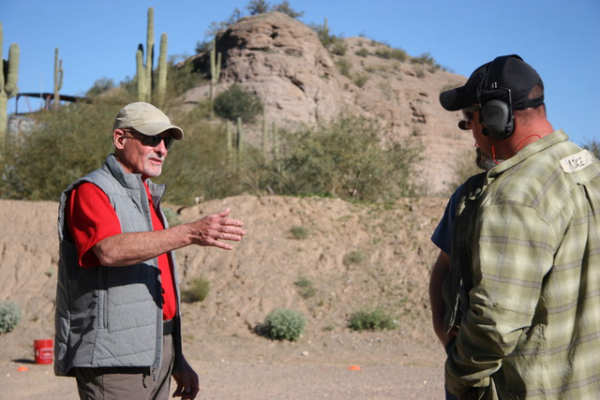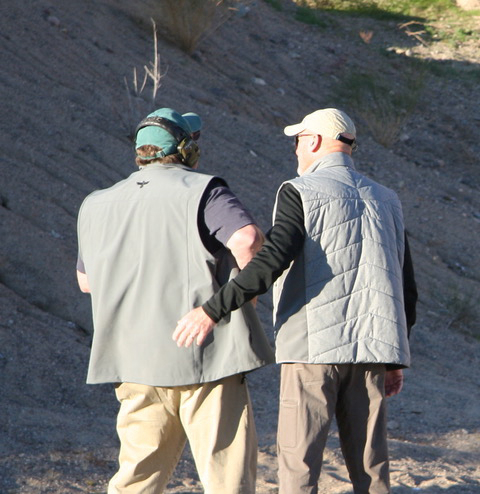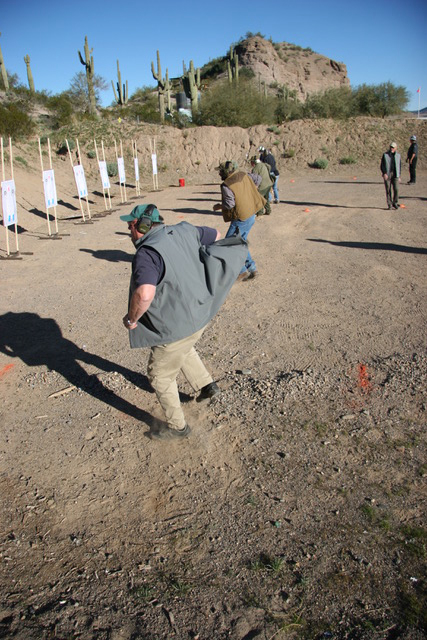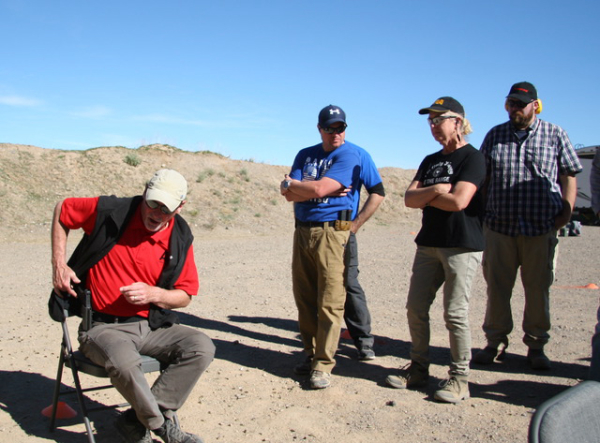This is the latest from our correspondent, Greg Moats --

When considering the history of our Republic, we are currently living in “interesting times,” a term that was ostensibly once used as a Chinese curse. The availability of diverse forms of shooting-competition and the proliferation of concealed-carry licenses have never been greater than they are today. The recent Church-shooting in Texas has validated what we’ve known all along, that good men with guns are the only solution to dealing with bad men with guns. Unfortunately the video of the event shows one of the church security guards being shot, due in part to bollixing a concealed-carry-draw. This is a sober reminder that being a good man with a gun is different than being a good man that’s good with a gun.
Shooting is fundamentally a pretty simple task; simple but not easy. I paraphrase a Colonel Cooper comment that a handgun requires more skill than a shovel to manipulate but distinctly less than a violin to master. One unfortunate reality is that while many have gone through the effort of getting their concealed carry licenses, few have troubled themselves beyond that point by actually developing skill at its mastery. Many of the states that require a shooting test in order to be “licensed,” have shooting standards that are ridiculously simple. I once shot the required course of fire for one state exam with my eyes closed and only dropped one point on the entire course. It’s probably disingenuous to get dogmatic about it since there are no other constitutionally guaranteed “rights” that an individual must be tested and licensed in order to exercise. The fact remains however that having the right to carry and having the ability to defend oneself are entirely different issues.
One of the blessings of the “Golden Age” in which we live is the availability of training. The downside is that anyone with a computer, a video camera and a touch of narcissism can promote themselves as one of the world’s leading experts and gain a following. I’m skeptical of any trainer that uses his military credentials in his initial pedigree and offers to reveal the “secrets” that they developed to stay alive during their covert deployment in some classified location. My “B.S. Meter” gets pegged when anyone criticizes modern competitive matches because, “that stuff will get you killed on the street,” or uses terms like “outdated” when referring to the teaching/writing of people like Jeff Cooper, Bill Jordan, Skeeter Skelton and Charles Askins. While there is no shortage of charlatans in the world, there is an infestation of them on shooting blogs/sites on the internet. The list of proven, superb trainers that have “earned the right” to teach in this serious arena is relatively short. One of the best is a frequent contributor to The Shooting Wire and The Tactical Wire, Dave Spaulding.

Dealing with the specific needs of each student is the hallmark of great training. Each of Dave’s students get personal, detailed coaching.
|
As a caveat, let me start by saying that I’m a training-junkie. I spent 24 years in the Sales, Management and Communications training industry. In the shooting arena, my first class was with Ray Chapman in 1978 and I’ve been taking classes ever since (I’m the type of person that Ken Campbell at Gunsite refers to as a “recidivist student”). For full disclosure, I’m a fan-boy of Spaulding having taken his 2 day Combative Pistol class also his 3 day version, his Kinetic Combat Pistol class and most recently his Advanced Covert Pistol class. His Covert Pistol course is exactly the type of class that every concealed carrier should take…..repetitively. It is a fighting course, not a shooting course; not a “one and done” program, it’s more like a yoga class than a history course. The purpose is not so much to gain information as it is to develop skill sets.
To be effective, training needs to be perceived in the correct context and have well defined objectives. Dave therefore begins every class with an orientation meeting. “Concealed carry techniques are nothing more than combative pistol techniques with the addition of garment removal. A gunfight is a linear event, therefore the single most important thing that you can do in a gunfight is to get the gun between you and your adversary which will require garment removal. The problem with garment removal is that too many people are cavalier about it and it should be a very deliberate action that’s done the same way every time,” Dave cautioned us.
Equipment
Spaulding makes it clear up front that the choice of gun, holster, magazine pouch, ammunition and cover-garment made by the student is irrelevant to him. Dave will explain his preferences but reiterates that he doesn’t care what the student uses. However, there are some basic equipment principles that he recommends. He suggests that the holster retain the handgun with a loaded magazine if it’s held upside down and shaken three times. Either leather or kydex is fine however he recommends kydex for the magazine pouch. He teaches students to index their middle finger on the bottom of the trigger guard as the initial contact with the handgun while drawing; therefore if there is not enough room to insert your fingers between the trouser band and the front strap of the pistol the handgun is sitting too low on the belt. Due to congenital mirror movement, he suggests that the magazine pouch be placed in the same location on the opposite side of the belt from the holster. If the holster is worn at 3 o’clock, the mag pouch should be placed at 3 o’clock on the opposite side; if worn in the appendix carry, the mag pouch goes in an appendix position, etc. For students wanting to carry a larger handgun such as a full sized Government Model 1911, he suggests that for most people it’s easier to conceal in an IWB. He summarizes his equipment discussion by saying, “find a gun, find a spot and leave it alone.”
Technique

Practicing the garment removal portion of the concealed-carry draw until it becomes almost intuitive and somewhat smooth.
|
As a professional trainer, Spaulding has a fairly consistent modus operandi; he would explain a technique, demo the technique, have the class practice the technique with unloaded handguns and then have the class actually shoot utilizing the technique. This process was utilized as he taught various garment removal procedures: the Hook, the Paddle-slide, the H&K, the Hand-slap, and what he calls the Count Dracula technique.
The entire class went thru these drills armed and carrying in the manner in which they arrived at the range that morning. Everyone then switched to a closed-front garment and an IWB holster. For some this was their daily configuration, for others it felt quite foreign. One and two hand draws were taught and practiced, then everyone switched to an open-front garment, IWB or OWB holster, again, for some this was a foreign configuration.
Dave teaches how to perform each technique and movement with the least amount of time, effort and energy expended, which is the definition of “efficiency.” Practice is conducted under his coaching until some modicum of smoothness is achieved. According to Dave, “smooth” is a lack of unnecessary motion which will eventually result in speed.
Movement
There are few hard and fast consistent realities in a gunfight, however one that is almost universal is that when things “go to guns” people move. Therefore, on the second day of the class, the element of movement was added. Particularly when wearing an open-front cover garment, movement complicates the garment removal process. An explosive side-step in the holster-side direction requires near perfection in hooking the front edge of the garment to keep momentum from causing it to sweep across the front of the body and further obstruct the draw. Side-steps, 90 and 180-degree pivots, and running procedures were demonstrated and practiced.
Seated Drawing


Whether sitting in a vehicle, a restaurant booth or as we’ve witnessed, the back pew of a church, drawing a concealed handgun can become a complex, fine-motor-skill. According to Dave, “When seated you have to create the space to get to your gun and this is the time when your garment removal has to be absolutely sure, you can’t flip the garment out of the way.” To accommodate this, Dave had us practice bending at the waist and rocking forward while seated to gain the space needed to sweep the garment out of the way. For me this was not an intuitive maneuver and felt foreign at first, however with repetition came comfort.
Conclusion
Although Spaulding’s Advanced Covert Pistol class as mentioned earlier is a fighting class not a shooting class, I managed to shoot 800 rounds during the 2 day experience. It did not cover high-speed, low drag competition techniques but highlighted the skills that a concealed carrier may actually need to employ to stay alive. At the conclusion I couldn’t help but wish that that security guard at the Texas church had experienced the program.
For information contact https://www.handguncombatives.com
Greg Moats was one of the original IPSC Section Coordinators appointed by Jeff Cooper shortly after its inception at the Columbia Conference. In the early 1980’s, he worked briefly for Bianchi Gunleather and wrote for American Handgunner and Guns. He served as a reserve police officer in a firearms training role and was a Marine Corps Infantry Officer in the mid-1970’s. He claims neither snake-eater nor Serpico status but is a self-proclaimed “training junkie.”